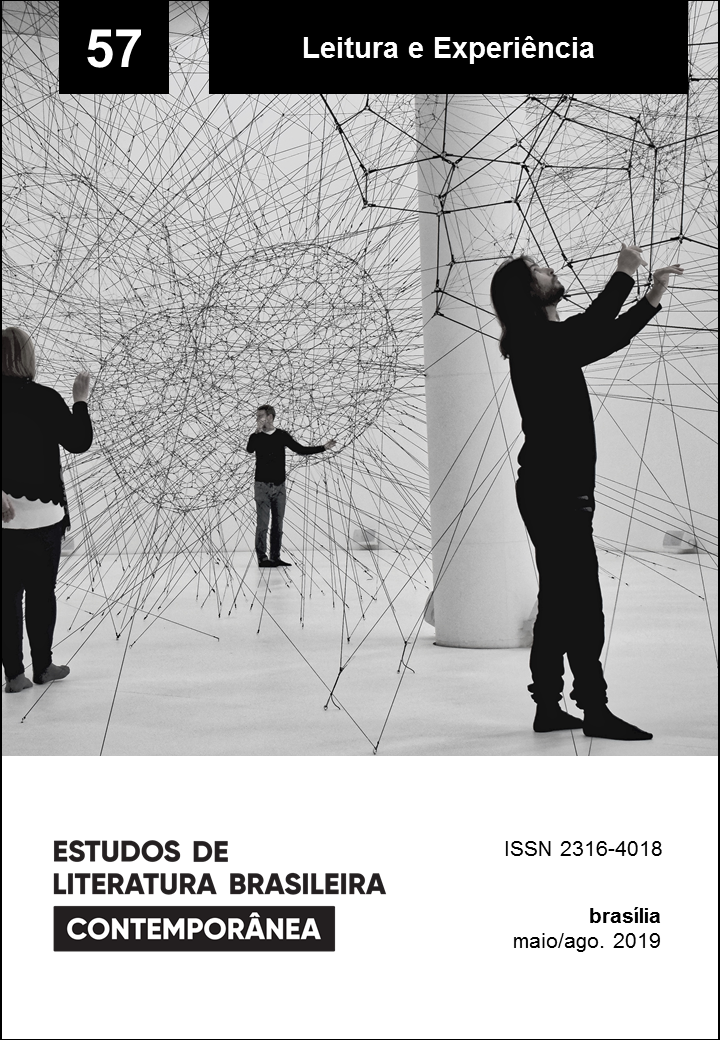A body of reading
DOI:
https://doi.org/10.1590/2316-40185715Keywords:
reader, body, performance, Elvira VignaAbstract
Como se estivéssemos em palimpsesto de putas, Elvira Vigna’s last book, tells the story of João, the IT associate of a publisher about to declare bankruptcy, whose only pleasure is having sex with prostitutes. The reader has access to the story through the narrator, a jobless designer who visits João at work every day. In a narrative composed of fragments, the author fosters a discussion about literature itself, placing the designer as both a reader and writer. She tells us the stories she hears from João, informing us that she fills in the gaps left by him for lack of detail. This article intends to reflect on the figure of the reader in Vigna’s book, a reader who compromises her whole body in reading and, in so doing, performs the reading.
References
BARTHES, Roland (2012). Escrever a leitura. In: BARTHES, Roland. O rumor da língua. São Paulo: Martins Fontes. p. 26-29.
DERRIDA, Jacques (2014). Essa estranha instituição chamada literatura: uma entrevista com Jacques Derrida. Belo Horizonte: Editora UFMG.
GUERÓN, Rodrigo (2012). Arte e política: estudos de Jacques Rancière. AISTHE, Rio de Janeiro, v. 6, n. 9, p. 34-46.
LOBO, Luíza (1987). Teorias poéticas do romantismo. Porto Alegre: Mercado Aberto.
MERQUIOR, José Guilherme (1979). De Anchieta a Euclides: breve história da literatura brasileira. Rio de Janeiro: José Olympio.
NASCIMENTO, Evando (2014). A literatura a demanda do outro. In: DERRIDA, Jacques. Essa estranha instituição chamada literatura: uma entrevista com Jacques Derrida. Belo Horizonte: Editora UFMG.
RANCIÈRE, Jacques (2017). Políticas da escrita. São Paulo: Editora 34.
VIGNA, Elvira (2016). Como se estivéssemos em palimpsesto de putas. São Paulo: Companhia das Letras.
ZUMTHOR, Paul (2014). Performance, recepção, leitura. São Paulo: Cosac Naify.
Downloads
Published
Issue
Section
License
Authors who publish in this journal agree to the following terms:
a) The authors maintain the copyright and grant the journal the right of first publication, the work being simultaneously licensed under the Creative Commons Attribution License-Non Commercial 4.0 which allows the sharing of the work with acknowledgment of the authorship of the work and publication this journal.
b) Authors are authorized to enter into additional contracts separately, for non-exclusive distribution of the version of the work published in this journal (eg publish in institutional repository or as a book chapter), with authorship recognition and publication in this journal.
c) Authors are allowed and encouraged to publish and distribute their work online (eg in institutional repositories or on their personal page) after the editorial process, as this can generate productive changes, as well as increase the impact and citation of published work (See The Effect of Free Access).
d) The authors of the approved works authorize the magazine to, after publication, transfer its content for reproduction in content crawlers, virtual libraries and the like.
e) The authors assume that the texts submitted to the publication are of their original creation, being fully responsible for their content in the event of possible opposition by third parties.


